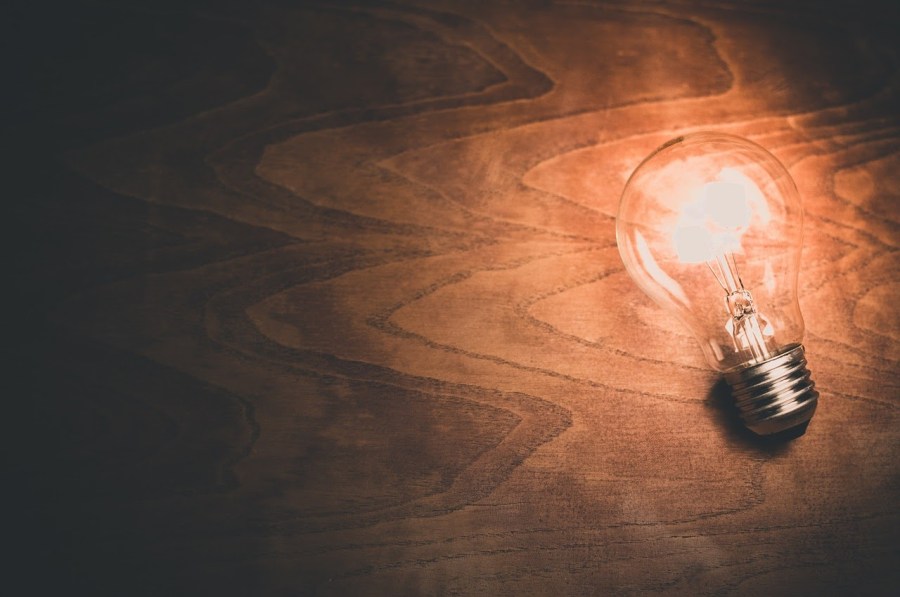Need Some Old Fashioned 100 Watt Light Bulbs

During the 1800s, many inventions revolutionized the United States and the world. One of these was the calorie-free seedling. With the invention of the calorie-free bulb, people began altering their homes with electricity and using the light bulb instead of fire for nighttime calorie-free. The effects of this invention were not all positive. With the calorie-free bulb now being used more frequently, the gas companies were suffering, and gas stocks went down.
The new invention of the light bulb also spurred the expansion of electrical power grids everywhere. The largest of these was starting time congenital in 1895 in Niagara Falls. At the time, this was the world'due south first power station. The light bulb brought about more inventions such as electrical appliances, the phonograph, and even other versions of the light bulb.
The long-term effects on society were noticed. People were staying up later in the evenings because of the lighting they now had, cities became more social in the evenings, and homes were safer now that they weren't being lit and heated by burn.
Who Invented the Lite Seedling?
Although Thomas Edison is credited with the invention of the light bulb in 1879, other inventors were working on diverse designs to produce electricity or light. In the year 1800, Alessandro Volta, an Italian inventor, was working on a way to generate electricity. He used zinc and copper for this invention and, in the process, the copper wire would glow and produce light.
Warren de la Rue designed a version of the light bulb in 1840. His bulb used copper wire and a platinum filament, and information technology worked successfully. However, the price of platinum was too high, preventing the invention from condign a success. Joseph Swan was an English language chemist that also came upwardly with this version of the calorie-free bulb in 1850. His was made with a carbonized paper filament simply didn't have the engineering science to make the vacuum pump of the bulb to work efficiently.
Edison discovered what the event was with Swan's design and came upwards with an invention that used a thinner filament that fabricated the seedling operate more efficiently. Edison'southward version of the lite bulb was considered a success in 1879 and, past 1880, he founded his own electrical company named Edison Electric Illuminating Company of New York.
H ow Does a Light Bulb Piece of work?
When Edison designed the first light seedling, information technology worked with the ability of electricity. The electricity traveled through a glass vacuum bulb to a delicate platinum filament to provide the low-cal. The vacuum of the drinking glass bulb would slow down the melting of the filament. This bulb would only last a few hours before burning out.
Today, the low-cal seedling is designed very differently. The metal base at the bottom of the bulb has two metal contacts to connect to an electrical excursion. 2 wires travel from the metallic contacts to a thin metal filament in the heart of the seedling. The glass bulb that surrounds the wires and filament contains an inert gas, usually argon. When an electrical current powers the light bulb, the energy travels through the wires to the filament to create low-cal. The modern-day light bulb, in more scientific terms, radiates light past a reaction between positively and negatively charged atoms.
T he Different Types of Lite Bulbs
The incandescent light seedling was the outset one put into utilise for the common home. Today, there are fluorescent lamps, compact fluorescent lamp (CFL) bulbs, element of group vii bulbs, and light-emitting diode (LED) bulbs.
I ncandescent Bulbs
This bulb used to exist the most commonly used in homes and other buildings. This seedling operates a little differently than the original invented past Edison. It brings light by passing a current through wires to a tungsten filament, which provides a glow. These bulbs have a life of nearly 700 to 1,000 hours.
F luorescent Bulbs
These bulbs are tubes made up of gases, such as mercury. The light works by an electric current traveling from cathodes on the ends of the bulb to the gases, which radiate free energy. The tubes have a phosphorus blanket, which takes the energy and converts it to low-cal. The fluorescent bulbs last longer but contain gases, so they need to be disposed of in a special way.
C FL
CFL bulbs are more energy-efficient than an incandescent bulb and last about 10,000 hours. Many homes replaced their incandescent bulbs with CFLs. These bulbs are a screw shape and operate with the same technology every bit the fluorescent tubes.
H alogen Lamps
Halogen lamps are pop in older floor lamps and car headlamps. These are much more than efficient and meaty than an incandescent seedling. Element of group vii lamps operate with a tungsten filament that is surrounded by a transparent casing. The bulb is filled with an inert gas and halogen, which increases the life and brightness of the light.
L ED
LED bulbs are the most popular found in homes and buildings all effectually the earth. These bulbs come in a variety of low-cal colors and are a elevation choice due to their free energy efficiency. The LED seedling works by an electric current traveling to a negatively charged diode, which creates a flow of electrons and protons.
0 Response to "Need Some Old Fashioned 100 Watt Light Bulbs"
Post a Comment